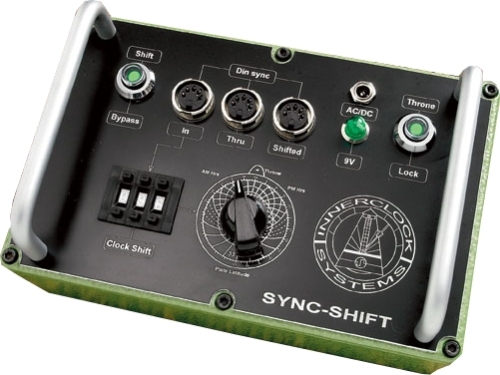sing any Din Sync Sequencer or Drum Machine as a slave device to hardware or software generated Midi Clock requires the use of a Midi Clock to Din Sync converter.

There are many of these in existence – Frostwave, Kenton, Philip Rees, Korg and Roland to name a few. There are also many sequencers and drum machines that perform internal Midi Clock to Din Sync conversion – Roland MSQ-700, SBX-10, Frostwave Fat Controller, Future Retro Mobius etc.
The conversion process between Midi Clock and Din Sync will always introduce some delay. Sometimes it is minimal and sometimes it is unusable. Either way it is perceivable and affects how we respond to the music being played both from a compositional perspective and as someone listening to the finished recording.
There are great advantages to using vintage Din Sync devices – they usually sound unique and in the majority of cases they have useful features not found on much of today’s electronic musical instruments – dedicated outputs for each instrument and external triggers for driving other analogue devices are two that come to mind.
Being hardware devices, many of these [the Roland TR-808 and TB-303 for instance] have hands-on, tonal controls that begged to be played live – they invite improvisation and as such create electronic music that has real expression and movement.
Midi timing (particularly when involves software) has its own share of issues that are beyond the scope of this introduction. The long term difficulties in achieving good midi timing and accurate synchronization particularly where multiple devices are concerned has fueled a growing trend towards electronic music composers abandoning this method of working in favour of a more singular computer-based approach where external performances are recorded as audio ‘loops’ and then re-sequenced and ‘tightened’ inside the software application. The widespread use of software synthesizers and sequencing ‘plug-ins’ also support this trend – the rarity and cost in sourcing original vintage hardware is a factor – but many composers who have access to both software and hardware choose the software option simply because midi timing and synchronization are no longer an issue when everything is happening inside the computer.
From our point of view, using a mouse or virtual midi controller connected to a laptop to adjust envelope decay time on a soft-synth is never going to provide the same player response as performing live on a hardware instrument.
In the same way, looping a 16 bar phrase of recorded audio is never going to sound as organic or have the same impact as a hardware device playing over the entire length of the composition.

The process is simple:
-Plug in your Sync-Shift.
-Connect your Din Sync Master device output to the Sync-Shift Din Sync Input.
-Connect the Sync-Shift ‘Shifted’ Din Sync output to your favourite Din Sync slave device.
-Set the push-button Clock Shift counter to 95 clocks [1 whole bar is 96 clocks] – the missing clock gives you room to fine tune the offset by ear with the rotary control.
-Make sure the Shift Bypass button is pushed in [Out means the Sync-Shift is Bypassed].
-Press play on your master device [Hardware or Software].
-The master device will start and approximately one whole bar later your Sync-Shifted Din Sync slave will start as well.
-Now use the rotary control to fine-tune the sync to your taste.
-When you are happy with how it all sounds – push the [Throne Lock] button to lock the offset.
Slave Din Sync Syncopation
Using Midi Clock and Din Sync always ensures that start times between connected devices is always the same. This is a good thing mostly. Sometimes, however, you might really like to hear that TB-303 riff playing against the groove – maybe starting on the 3 instead of the 1. You could re-write the pattern in the TB-303 shifting all the notes, accents and slides individually forward by three steps if you had the time or you could record a bar as audio and trigger the phrase in software but then you would lose the live feel and the hands-on control.
The price: $645 incl VAT.
More info on the Innerclock website.
